Tao Ji
Mitigating Object Hallucinations in MLLMs via Multi-Frequency Perturbations
Mar 19, 2025Abstract:Recently, multimodal large language models (MLLMs) have demonstrated remarkable performance in visual-language tasks. However, the authenticity of the responses generated by MLLMs is often compromised by object hallucinations. We identify that a key cause of these hallucinations is the model's over-susceptibility to specific image frequency features in detecting objects. In this paper, we introduce Multi-Frequency Perturbations (MFP), a simple, cost-effective, and pluggable method that leverages both low-frequency and high-frequency features of images to perturb visual feature representations and explicitly suppress redundant frequency-domain features during inference, thereby mitigating hallucinations. Experimental results demonstrate that our method significantly mitigates object hallucinations across various model architectures. Furthermore, as a training-time method, MFP can be combined with inference-time methods to achieve state-of-the-art performance on the CHAIR benchmark.
The Role of Visual Modality in Multimodal Mathematical Reasoning: Challenges and Insights
Mar 06, 2025Abstract:Recent research has increasingly focused on multimodal mathematical reasoning, particularly emphasizing the creation of relevant datasets and benchmarks. Despite this, the role of visual information in reasoning has been underexplored. Our findings show that existing multimodal mathematical models minimally leverage visual information, and model performance remains largely unaffected by changes to or removal of images in the dataset. We attribute this to the dominance of textual information and answer options that inadvertently guide the model to correct answers. To improve evaluation methods, we introduce the HC-M3D dataset, specifically designed to require image reliance for problem-solving and to challenge models with similar, yet distinct, images that change the correct answer. In testing leading models, their failure to detect these subtle visual differences suggests limitations in current visual perception capabilities. Additionally, we observe that the common approach of improving general VQA capabilities by combining various types of image encoders does not contribute to math reasoning performance. This finding also presents a challenge to enhancing visual reliance during math reasoning. Our benchmark and code would be available at \href{https://github.com/Yufang-Liu/visual_modality_role}{https://github.com/Yufang-Liu/visual\_modality\_role}.
Towards Economical Inference: Enabling DeepSeek's Multi-Head Latent Attention in Any Transformer-based LLMs
Feb 20, 2025Abstract:Multi-head Latent Attention (MLA) is an innovative architecture proposed by DeepSeek, designed to ensure efficient and economical inference by significantly compressing the Key-Value (KV) cache into a latent vector. Compared to MLA, standard LLMs employing Multi-Head Attention (MHA) and its variants such as Grouped-Query Attention (GQA) exhibit significant cost disadvantages. Enabling well-trained LLMs (e.g., Llama) to rapidly adapt to MLA without pre-training from scratch is both meaningful and challenging. This paper proposes the first data-efficient fine-tuning method for transitioning from MHA to MLA (MHA2MLA), which includes two key components: for partial-RoPE, we remove RoPE from dimensions of queries and keys that contribute less to the attention scores, for low-rank approximation, we introduce joint SVD approximations based on the pre-trained parameters of keys and values. These carefully designed strategies enable MHA2MLA to recover performance using only a small fraction (0.3% to 0.6%) of the data, significantly reducing inference costs while seamlessly integrating with compression techniques such as KV cache quantization. For example, the KV cache size of Llama2-7B is reduced by 92.19%, with only a 0.5% drop in LongBench performance.
EvoLlama: Enhancing LLMs' Understanding of Proteins via Multimodal Structure and Sequence Representations
Dec 16, 2024



Abstract:Current Large Language Models (LLMs) for understanding proteins primarily treats amino acid sequences as a text modality. Meanwhile, Protein Language Models (PLMs), such as ESM-2, have learned massive sequential evolutionary knowledge from the universe of natural protein sequences. Furthermore, structure-based encoders like ProteinMPNN learn the structural information of proteins through Graph Neural Networks. However, whether the incorporation of protein encoders can enhance the protein understanding of LLMs has not been explored. To bridge this gap, we propose EvoLlama, a multimodal framework that connects a structure-based encoder, a sequence-based protein encoder and an LLM for protein understanding. EvoLlama consists of a ProteinMPNN structure encoder, an ESM-2 protein sequence encoder, a multimodal projector to align protein and text representations and a Llama-3 text decoder. To train EvoLlama, we fine-tune it on protein-oriented instructions and protein property prediction datasets verbalized via natural language instruction templates. Our experiments show that EvoLlama's protein understanding capabilities have been significantly enhanced, outperforming other fine-tuned protein-oriented LLMs in zero-shot settings by an average of 1%-8% and surpassing the state-of-the-art baseline with supervised fine-tuning by an average of 6%. On protein property prediction datasets, our approach achieves promising results that are competitive with state-of-the-art task-specific baselines. We will release our code in a future version.
AntLM: Bridging Causal and Masked Language Models
Dec 04, 2024Abstract:Causal Language Modeling (CLM) and Masked Language Modeling (MLM) are two mainstream learning paradigms based on Transformer networks, specifically the Decoder-only and Encoder-only architectures. The strengths of each paradigm in downstream tasks have shown a mix of advantages and disadvantages. In the past BabyLM Challenge 2023, although the MLM paradigm achieved the best average performance, the CLM paradigm demonstrated significantly faster convergence rates. For the BabyLM Challenge 2024, we propose a novel language modeling paradigm named $\textbf{AntLM}$, which integrates both CLM and MLM to leverage the advantages of these two classic paradigms. We chose the strict-small track and conducted experiments on two foundation models: BabyLlama, representing CLM, and LTG-BERT, representing MLM. During the training process for specific foundation models, we alternate between applying CLM or MLM training objectives and causal or bidirectional attention masks. Experimental results show that combining the two pretraining objectives leverages their strengths, enhancing overall training performance. Under the same epochs, $AntLM_{BabyLlama}$ improves Macro-average by 1%, and $AntLM_{LTG-BERT}$ achieves a 2.2% increase over the baselines.
Enhancing LLM Reasoning via Critique Models with Test-Time and Training-Time Supervision
Nov 25, 2024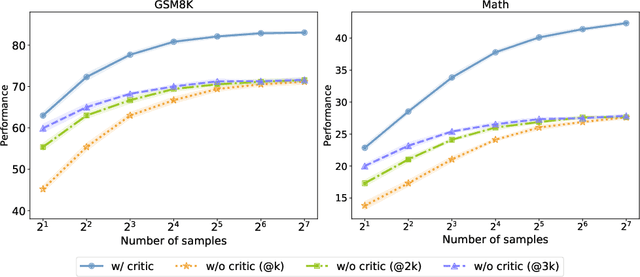

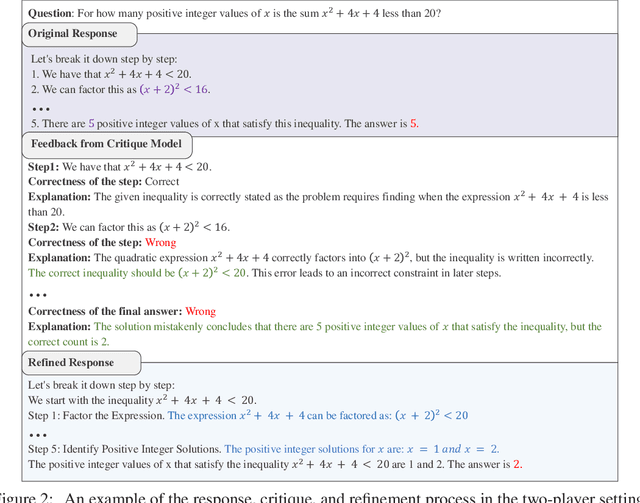

Abstract:Training large language models (LLMs) to spend more time thinking and reflection before responding is crucial for effectively solving complex reasoning tasks in fields such as science, coding, and mathematics. However, the effectiveness of mechanisms like self-reflection and self-correction depends on the model's capacity to accurately assess its own performance, which can be limited by factors such as initial accuracy, question difficulty, and the lack of external feedback. In this paper, we delve into a two-player paradigm that separates the roles of reasoning and critique models, where the critique model provides step-level feedback to supervise the reasoning (actor) model during both test-time and train-time. We first propose AutoMathCritique, an automated and scalable framework for collecting critique data, resulting in a dataset of $76,321$ responses paired with step-level feedback. Fine-tuning language models with this dataset enables them to generate natural language feedback for mathematical reasoning. We demonstrate that the critique models consistently improve the actor's performance on difficult queries at test-time, especially when scaling up inference-time computation. Motivated by these findings, we introduce the critique-based supervision to the actor's self-training process, and propose a critique-in-the-loop self-improvement method. Experiments show that the method improves the actor's exploration efficiency and solution diversity, especially on challenging queries, leading to a stronger reasoning model. Lastly, we take the preliminary step to explore training self-talk reasoning models via critique supervision and showcase its potential. Our code and datasets are at \href{https://mathcritique.github.io/}{https://mathcritique.github.io/}.
Multi-Programming Language Sandbox for LLMs
Oct 30, 2024



Abstract:We introduce MPLSandbox, an out-of-the-box multi-programming language sandbox designed to provide unified and comprehensive feedback from compiler and analysis tools for Large Language Models (LLMs). It can automatically identify the programming language of the code, compiling and executing it within an isolated sub-sandbox to ensure safety and stability. In addition, MPLSandbox also integrates both traditional and LLM-based code analysis tools, providing a comprehensive analysis of generated code. MPLSandbox can be effortlessly integrated into the training and deployment of LLMs to improve the quality and correctness of their generated code. It also helps researchers streamline their workflows for various LLM-based code-related tasks, reducing the development cost. To validate the effectiveness of MPLSandbox, we integrate it into training and deployment approaches, and also employ it to optimize workflows for a wide range of real-world code-related tasks. Our goal is to enhance researcher productivity on LLM-based code-related tasks by simplifying and automating workflows through delegation to MPLSandbox.
Have the VLMs Lost Confidence? A Study of Sycophancy in VLMs
Oct 15, 2024



Abstract:In the study of LLMs, sycophancy represents a prevalent hallucination that poses significant challenges to these models. Specifically, LLMs often fail to adhere to original correct responses, instead blindly agreeing with users' opinions, even when those opinions are incorrect or malicious. However, research on sycophancy in visual language models (VLMs) has been scarce. In this work, we extend the exploration of sycophancy from LLMs to VLMs, introducing the MM-SY benchmark to evaluate this phenomenon. We present evaluation results from multiple representative models, addressing the gap in sycophancy research for VLMs. To mitigate sycophancy, we propose a synthetic dataset for training and employ methods based on prompts, supervised fine-tuning, and DPO. Our experiments demonstrate that these methods effectively alleviate sycophancy in VLMs. Additionally, we probe VLMs to assess the semantic impact of sycophancy and analyze the attention distribution of visual tokens. Our findings indicate that the ability to prevent sycophancy is predominantly observed in higher layers of the model. The lack of attention to image knowledge in these higher layers may contribute to sycophancy, and enhancing image attention at high layers proves beneficial in mitigating this issue.
Generation with Dynamic Vocabulary
Oct 11, 2024



Abstract:We introduce a new dynamic vocabulary for language models. It can involve arbitrary text spans during generation. These text spans act as basic generation bricks, akin to tokens in the traditional static vocabularies. We show that, the ability to generate multi-tokens atomically improve both generation quality and efficiency (compared to the standard language model, the MAUVE metric is increased by 25%, the latency is decreased by 20%). The dynamic vocabulary can be deployed in a plug-and-play way, thus is attractive for various downstream applications. For example, we demonstrate that dynamic vocabulary can be applied to different domains in a training-free manner. It also helps to generate reliable citations in question answering tasks (substantially enhancing citation results without compromising answer accuracy).
Investigating and Mitigating Object Hallucinations in Pretrained Vision-Language (CLIP) Models
Oct 04, 2024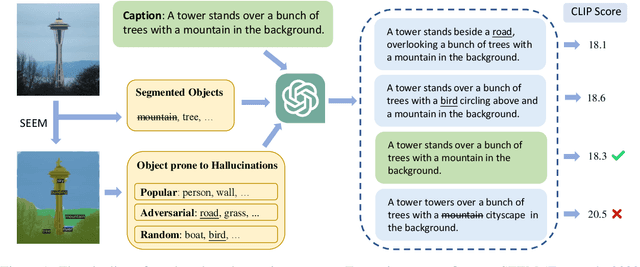
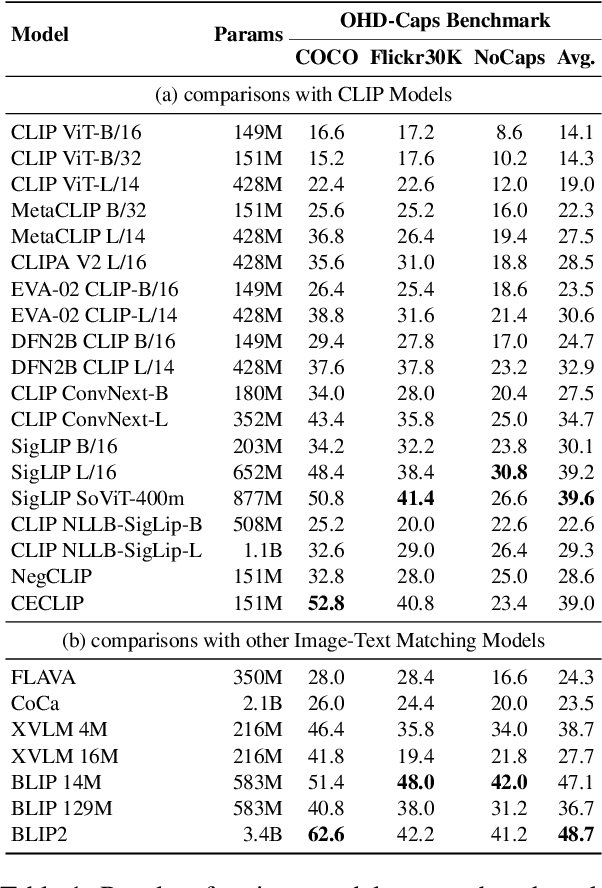
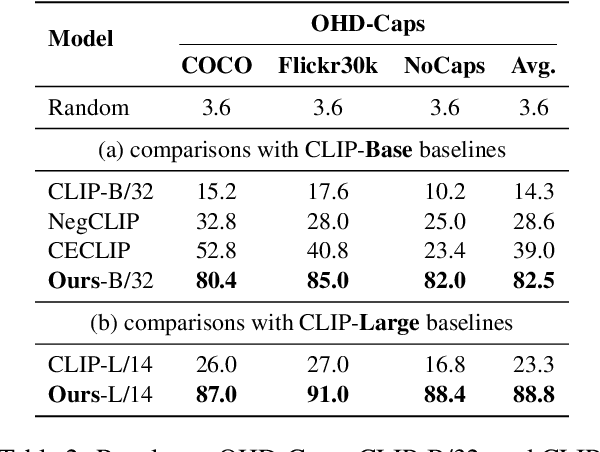
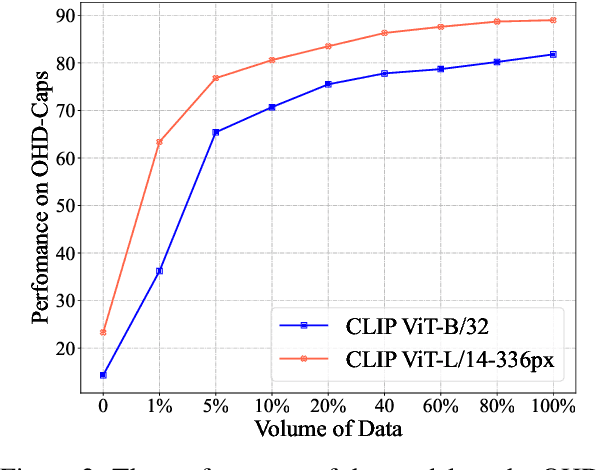
Abstract:Large Vision-Language Models (LVLMs) have achieved impressive performance, yet research has pointed out a serious issue with object hallucinations within these models. However, there is no clear conclusion as to which part of the model these hallucinations originate from. In this paper, we present an in-depth investigation into the object hallucination problem specifically within the CLIP model, which serves as the backbone for many state-of-the-art vision-language systems. We unveil that even in isolation, the CLIP model is prone to object hallucinations, suggesting that the hallucination problem is not solely due to the interaction between vision and language modalities. To address this, we propose a counterfactual data augmentation method by creating negative samples with a variety of hallucination issues. We demonstrate that our method can effectively mitigate object hallucinations for CLIP model, and we show the the enhanced model can be employed as a visual encoder, effectively alleviating the object hallucination issue in LVLMs.
 Add to Chrome
Add to Chrome Add to Firefox
Add to Firefox Add to Edge
Add to Edge